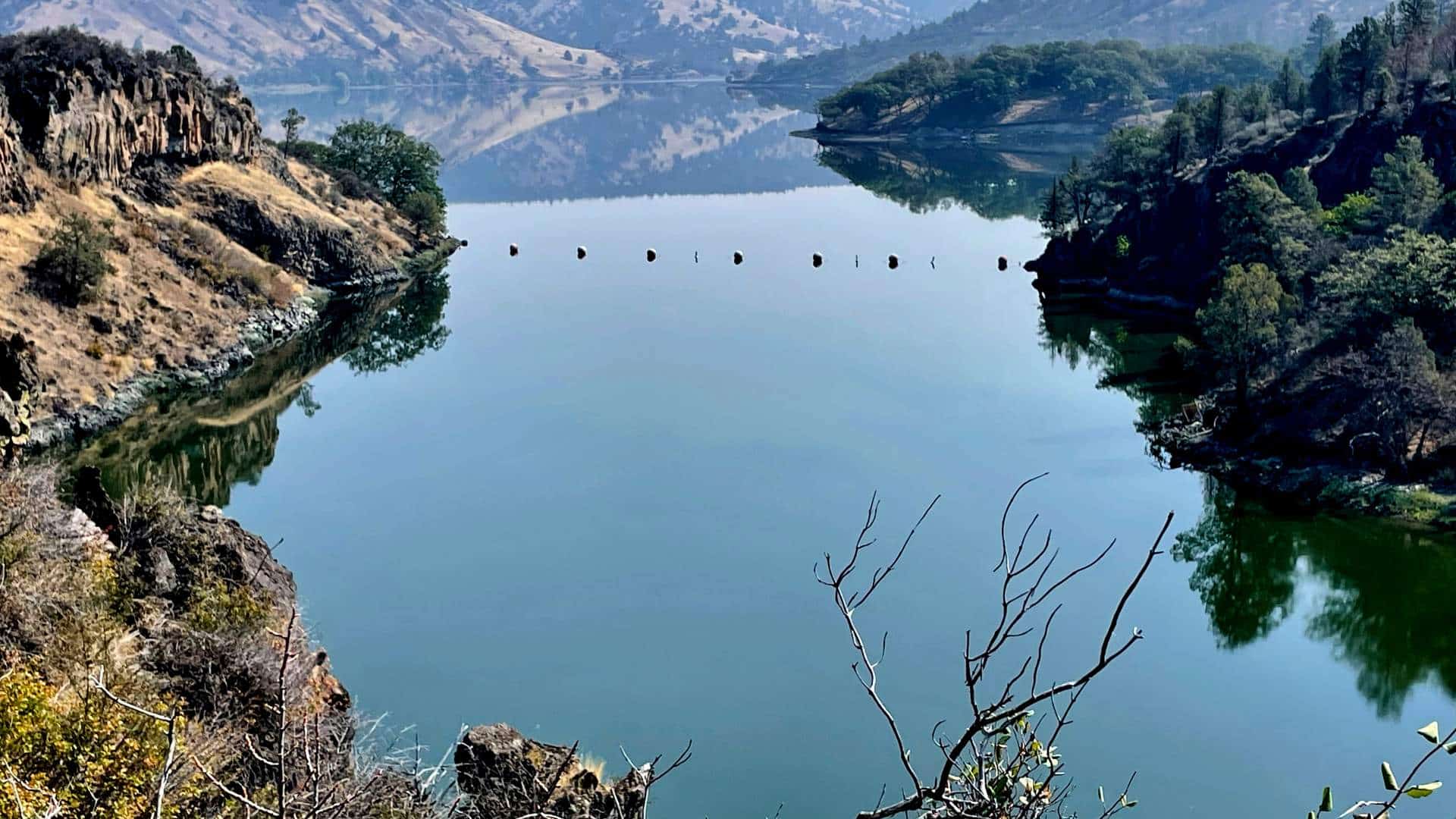Taking down massive dams is one thing. Now can we restore the land to what it was a century ago?

The Copco 1 Dam reservoir in Hornbook, California 17 September 2023, before the dam was breached in January 2024 and the water drained. (AP Photo/Haven Daley)
This article was produced exclusively for News Decoder’s global news service. It is through articles like this that News Decoder strives to provide context to complex global events and issues and teach global awareness through the lens of journalism. Learn how you can incorporate our resources and services into your classroom or educational program.
A voice echoed through the canyon.
“Fire in the hole, fire in the hole, fire in the hole!”
Then a reverberating boom. An unstoppable mass of frothing brown water burst from a pipe at the base of the old mossy Copco 1 Dam in Northern California on 24 January 2024. It is one of four dams being removed on the Klamath River in the world’s biggest dam removal project.
The restoration of the Klamath marks a massive victory for the Native American tribes that had been robbed of an integral part of their culture and the environmental activists that had fought alongside them for years to take the dams down.
“Having the same tribal people who have been doing this work for tens of thousands of years allowed access to their habitat again is more important than anyone can really understand,” said Frankie Myers, chairman of the Yurok Tribe, whose lands stretch along the Klamath River. “We see it in our tribal communities, the positive impact when we look at restoration holistically, when we work together to restore balance to the world around us recognizing how we got here.”
The damning effects of dams
Over the last decade, the negative effects of dams on river ecology have become evident around the world. Dams disrupt the ecosystem on many fronts: they halt fish migration, change water temperatures and interrupt the nutrient cycle by trapping vital nutrients in massive sediment build-ups.
The consequences have devastated not only local wildlife, but also the human communities whose reliance on the wildlife predates the dams. In response, conservation and human rights groups worldwide have rallied to tear dams down.
In Europe, a coalition of seven organizations formed Dam Removal Europe. Since its conception in 2016, the coalition has helped in the removal of more than 6,200 river barriers across 26 European countries. Despite its success, a vast majority of these removals are of relatively small barriers. Large-scale dam removals have remained mostly uncharted territory.
But on the other side of the globe, a dam removal of unprecedented scale has begun and serves as a potential model for future removal projects.
In the United States, nestled between the rolling forested hills of Northern California and Southern Oregon, the Klamath River has served as a lifeblood for the local people since before European colonization.
A people connected by a river
The Yurok Tribe has one of the deepest connections with the river. It once served as the primary provider of food for the tribe, and their lives and culture were centered around the bounty of life provided by the waterway.
This changed in 1908 with the construction of the Klamath Dam.
Between 1908 and 1962, four dams were constructed along the Klamath for the sole purpose of generating power for PacifiCorp, a utility company that currently operates the largest energy grid in the western United States.
The consequences were felt almost immediately.
Water flows out of the Copco 1 Dam in Northern California 24 January 2024. Video courtesy of Swiftwater Films via YouTube.
The dam hindered the migration of Coho and Chinook salmon, fish that are vital both to the people in the region and the river’s ecosystem, and destroyed their spawning habitat.
It polluted the water with toxic algae blooms from warmer water temperatures and killed off any species not suited for the changed water conditions.
Doubling down on the damage
Instead of reversing the damage caused by the dams, the U.S. government at first opted to strip away the fishing rights of the tribes on the Klamath in a vain attempt to slow the rapidly declining fish populations.
Local tribes would spend decades in court fighting to reverse this decision. By the time they had their rights back, many of the species that once swarmed the Klamath were now in peril and protected by the Endangered Species Acts.
Despite decades of harm caused by the construction of the Klamath dams, the issue did not receive national attention until an unprecedented ecological disaster horrified the public in 2002.
The region was facing a drought at the time, and more water was diverted for local farms. This, combined with the already unnaturally-high water temperature, led to the rapid spread of gill rot. An estimated 33,000 Chinook salmon died. It was the largest salmon kill in the history of the western United States. After this event, the Un-Dam the Klamath movement finally began to pick up steam.
In 2010, activists tried, but failed, to get federal legislation to force an agreement with PacifiCorp to take down the dams. It took another six years for an agreement to happen, this time without the federal government’s involvement.
Bringing together parties to bring down the dams
The 2016 agreement was backed not only by PacifiCorp but by the states of Oregon and California, six different tribal governments and a host of NGOs ranging from fisheries to conservation nonprofits.
It allowed the parties to bypass the federal government and shifted the financial responsibility onto the states and PacifiCorp for removal of the dams by 2020. And it created the Klamath River Renewal Corp., a nonprofit company formed by the signatories, that would take ownership of the dams and oversee their removal.
Despite several delays, the first of the four dams was removed on 23 October 2023, and the remaining dams are scheduled to be completed by the end of 2024.
The Klamath Dam removal project will be the world’s largest dam removal to date. It involves the removal of four different dams totaling 400 vertical feet (122 m) and costing $500 million. The removal will free more than 400 miles (644 km) of habitat for salmon and other fish.
The process of the project is broken into five stages. The first is Operational Drawdown, where over several months water was gradually released from the reservoirs until they were at minimum functional capacity.
Draining the lakes
In the second stage, the remainder of the reservoirs were fully emptied and sediment build-up was released.
The third stage is called the Reservoir Refilling and Releasing period and is currently underway until the Demolition stage begins in May.
An important part of this stage is the restoration of the river and the land around it. Leading that project is Dave Coffman, the Klamath Restoration project manager for Resource Environmental Solutions, a Texas-based company. It is his job to figure out how to revegetate places where plant life hasn’t grown in over a hundred years.
“We’ve collected 13–15 million seeds by hand, primarily through our partnership with the Yurok Tribe,” Coffman said.
Nurseries across the West Coast have propagated the plants and produced more than 17 billion seeds, that are then laid down in soil mixes at the bottom of the reservoir, Coffman said.
The seeds constitute 98 different native plants that are integral to the ecosystem and were specifically chosen because of their cultural significance and their restorative properties for the soil conditions.
Helping nature heal itself
Speaking at a press conference in February, Klamath River Renewal Corp. CEO Mark Bransom said that this is especially important because of the most dangerous and controversial aspect of dam removal: toxic sediment build-up released into the river.
“We’ve estimated that there were about 17–20 million cubic yards of sediment that have accumulated behind the dams over the last century,” Bransom said. A third of that is expected to travel downstream which will likely affect the water quality in downstream areas.
Siskiyou County, for example, released a warning advisory in early March for residents to stay clear of the Klamath because of the high toxic metal contents found after the drawdown.
“This was the period of the year that tribes and fisheries agencies made the decision that would be the best time of the year,” Bransom said. “We don’t have adult salmon in the river system, most of the juveniles are up in the tributaries and have not yet started their migration to the ocean, so this was really the optimal time to initiate the drawdown and mobilize this amount of sediment down the river.”
The demolition of the three remaining dams is projected to be finished by September 2024, bringing in the final stage: the Klamath River Reconnection. This will involve the breaching of the cofferdam — an enclosed area designed to allow water to be drained — and restoring the historic flow of the Klamath River.
Full restoration will take years and a concerted effort from the indigenous tribes and California government to revegetate the river and surrounding landscape to its former natural beauty. But they’ve fought for years just to get to this point.
“Rivers need to run free,” said Yurok Chair Frankie Myers. “Fish need access to their habitat in the same way that Tribal people do. We’ve been restorationists our entire time on this planet, and it’s amazing to see what we can do when we’re allowed to be in our habitat again.”
Correction: An earlier version of the story said the breach of the Copco 1 dam occurred in January 2023. It occurred in January 2024.
Three questions to consider:
- How did the construction of dams on the Klamath River affect the region?.
- What is one important step in the removal of the dams on the Klamath River?
- Do you think dams for hydroelectricity can be a good option for producing energy?

Liam Gwynn is a freelance journalist in Northern California. He graduated from Cal Poly Humboldt with a bachelor’s degree in journalism and a minor in environmental ethics. Gwynn specializes in covering the environmental crisis across the Pacific Northwest and the intersectionality between human rights and environmental protection.
Read more News Decoder stories about the environment:

Why is it never mentioned that there are California Fish and Wildlife Fish Hatcheries at the base of the dams, like Iron Gate, that have been spawning, hatching, rearing and releasing billions of fingerling salmon and steelhead back into the Klamath to continue their life journey?